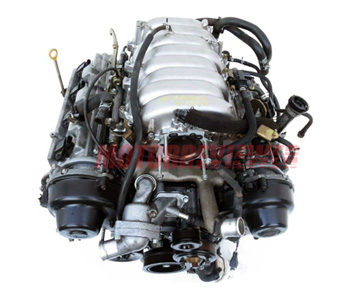Toyota 2UZ-FE 4.7L Engine Specs, Problems, Reliability, Info

The Toyota's 4.7-liter V8 engine is a well-known member of the UZ family. The 2UZ-FE engine was developed with a purpose of using in big trucks and SUVs. That is why it has more significant displacement, low-rev, and high-torque output.
The 1UZ-FE and 3UZ-FE have aluminum cylinder blocks, while the 2UZ-FE engine had a cast iron block - more reliable and cheaper material. Unfortunately, it severely affected the weight of the engine. But in the rest, the 2UZ engine block has the same design and dimensions except increased bore and stroke. It also has a 90-degree 'V' angle, a 21-mm cylinder bank offset, and a bore pitch of 105.5 mm. The engine has a steel crankshaft with eight counterweights and five main journals (the 1UZ crankshaft has six journals), forged and sintered connecting rods, and aluminum alloy pistons with skirts coated with tin plating for friction reduction.
On top of the cylinder's bank, there are aluminum heads. Each one has intake and exhaust camshafts and four valves per cylinder. The engine got the same method for camshaft rotation: the intake camshafts are driven by a timing belt, and the exhaust camshafts are driven by gears on the intake camshaft. The design of the valvetrain for 2UZ is the same as for 1UZ. The exhaust and intake valves are located on opposite sides with an angle of 21.55 degrees. The diameter of the intake valves is 34.5 mm, and the exhaust valves have a 29.0 mm diameter (the sizes of the diameters are identical to the later version of the 1UZ-FE with VVT-i). The engine has steel solid valve lifters, so valve clearances need a periodic adjustment.
The early versions of the 2UZ-FE had a simple aluminum intake manifold with a long intake manifold port. The engine used a heat-barrier gasket between two metal gaskets fitted between the intake manifold and each cylinder head. In the first years of production, the engine had a conventional throttle body, and the electronically controlled throttle body system (Toyota's ETCS-i system) was introduced in late 2002. From the beginning, the 2UZ-FE engine had sequential multiport fuel injection (SFI). The injection system used eight four-hole type fuel injectors (one for each cylinder), the mass air flow meter, and two air-fuel ratio sensors. The engine is equipped with Toyota's Direct Ignition System (DIS), which uses individual ignition coils for all eight cylinders and iridium spark plugs. In addition to that, there are two knock sensors and the Electronic Spark Advance technology for management and adjustment of ignition timing to prevent knocking.
The 2UZ-FE VVT-i Engine
All post-2007 2UZ-FE engines are equipped with Variable Valve Timing, an intelligent system whose shorter name is VVTi. The system controls almost all the essential parameters of the engine: throttle position, coolant temperature, air volume, etc. According to this information, it can adjust intake camshaft timing and improve the output and efficiency of the engine at low, mid, and high rpm. The second recognizable feature is a plastic intake manifold with variable intake port length. Toyota's Acoustic Control Induction System (ACIS) controls the range. The system has two stages of intake port length: the long one is for low engine speeds, and the short one is for higher engine speeds.
Inside the 2UZ-FE VVTi engine, there are new light pistons and oil jets in the cylinder block to cool them. The compression ratio was increased to 10.0:1 to make burning fuel more efficient. In 2010, the 2UZ-FE VVTi replaced the old engine completely. But from 2008 on, the 4.7-liter engine was gradually replaced by the new 5.7-liter 3UR-FE and 4.6-liter 1UR-FE engines.
Engine Specs
Oil recommendations and capacity may vary depending on the car model, year, and market. Please check the service manual specific to your vehicle!
Toyota 4.7 V8 2UZ-FE Engine Problems and Reliability
The 2UZ-FE engines are almost bulletproof, the most reliable and durable engines from the Toyota Corporation. These engines do not have any design flaws, meaning lash, noise, or wheezing cannot be found. The engine has a timing belt that needs replacement every 90,000 miles. The timing belt is costly, but on the other hand, it costs a lot of extra money to repair the considerable engine disaster because the pistons will hit the valves if the timing belt breaks. Thankfully, the cast iron block is more durable and repairable more easily.
The engine's longevity depends on how well and periodically it is maintained, the quality of oil and gas, the driving style, and the conditions. But the non-problem average mileage for cars with the 2UZ-FE is about 300,000 miles.
